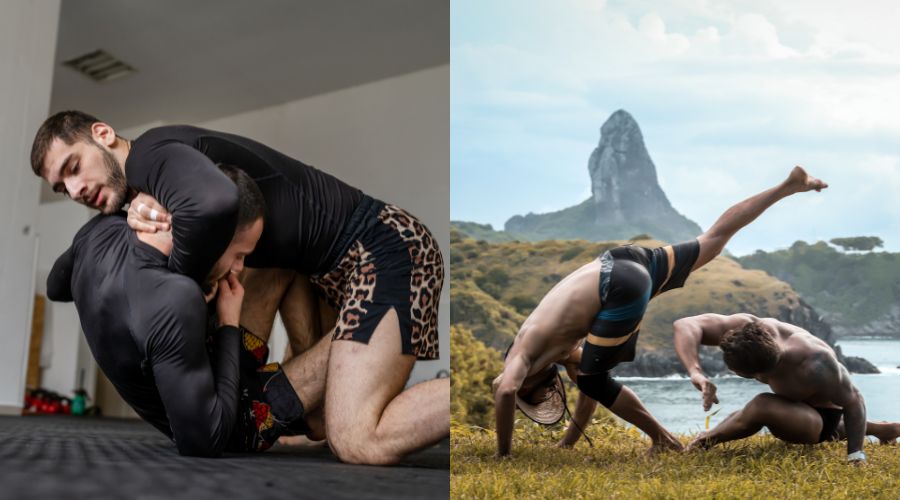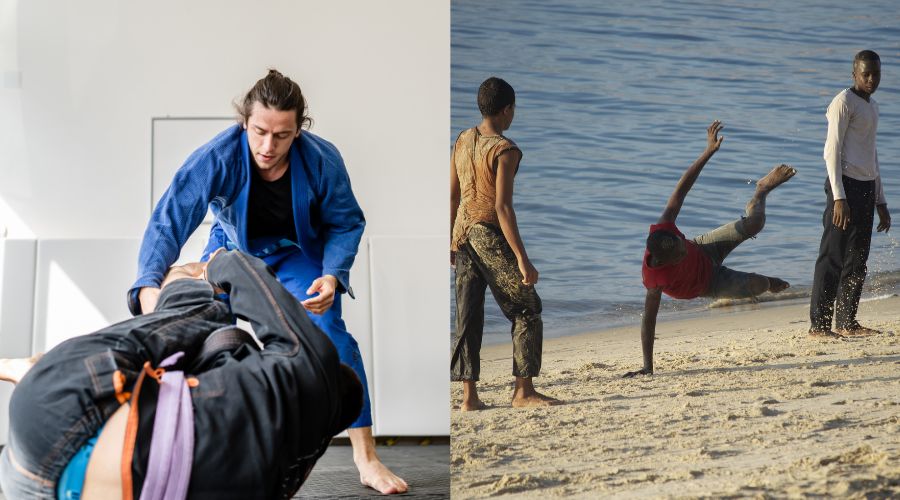Brazilian jiu-jitsu is far from the only “native” martial art in the South American country. There are several styles, some more obscure, others better known, but the most popular outside of BJJ has to be Capoeira. On the surface, there aren’t many similarities, but the two styles have crossed paths both as rivals and as compliments to each other. Do you know how they stack up?
Jiu-jitsu is a grappling martial art focused on realism, effectiveness, and competition and uses mainly ground positions and submission holds. On the other hand, Capoeira is a mixture of martial arts, dancing, music, and spirituality characterized by rhythmic, acrobatic movements.
Most of you are jiu-jitsu practitioners and perhaps have only a curiosity about Capoeira from a cultural perspective. Still, the traditional dancing martial art may bring some unexpected benefits for us grapplers.
What Is BJJ
Brazilian jiu-jitsu is a grappling martial art and combat sport that excels at ground fighting through leverage and technique. BJJ features many positions and submissions used to dominate an opponent on the ground.
Brazilian jiu-jitsu was developed in the early 20th century after Japanese judoka Mitsuyo Maeda started passing his skills and knowledge to students in Brazil, in which the Gracie family would prove instrumental.
Under the influence of judo, traditional jiu-jitsu, and the catch wrestlers often fighting in Brazil, the Gracies created a unique style focused predominantly on the ground aspect of fighting.
In the 1980s, members of the Gracie family went to the USA to popularize their style, and the big breakthrough came with the inception of the UFC, where Royce Gracie won three of the first four editions and showcased to the whole world the importance of grappling.
Today, the most popular form of BJJ is the grappling-only sports version, which has millions of practitioners and followers worldwide and a very well-developed competition scene. At the same time, BJJ remains a core element of MMA.
What Is Capoeira
Capoeira combines martial arts and dance, singing, and playing instruments. It’s an art that blends some fighting elements and is characterized by complex and highly acrobatic moves accompanying live-performed music.
Capoeira is considered a national heritage in Brazil and is widely celebrated worldwide.
Capoeira first appeared in Brazil via enslaved Africans during colonial times. They started mixing fighting techniques with music and dancing to disguise that they were actually fighting.
During the 19th century, a street fighting style called capoeira carioca was developed, which was used for actual fighting and had little to do with the stylized art we know today.
Because of the violent nature of the art, it was banned for several decades until legendary Capoeira Master Mestre Bimba opened the first official school in Bahia, Brazil, in 1932.
He established a disciplined method of teaching and training the art as a form of self-defense and athletics, blending dancing and athletic strikes in a style called Capoeira Regional, which is the most popular today.
Key Differences Between BJJ And Capoeira

Capoeira and BJJ are very different and would perhaps never be compared if they weren’t coming from the same place. Because of this, the two styles have also clashed on many occasions, making the comparison and rivalry between the two inevitable.
But also remember there are many manifestations of Capoeira, and it’s difficult to compare it to a single conclusive martial art.
Techniques
There are almost no crossing points between the techniques used in BJJ and Capoeira. The ground is the domain of jiu-jitsu, and positioning is one of the most important concepts. Positions like mount, back control, side control, and others are used to control the opponent, while the unique aspect is the guards, which allow you to fight effectively off the back.
For finishing the fight, a BJJ practitioner can choose between hundreds of possible submission holds like chokes, strangulations, joint locks, spinal twists, and other painful moves.
Capoeira techniques include a lot of acrobatics and kicks, with the main emphasis placed on the interaction between kicks and their evasion. There are various forms of push kicks, crescent kicks, sweeps, and distinct moves like the L-kick and scorpion kicks. All of this is done rhythmically, with specific stances and dance-like movements.
Rules and Matches
Capoeira is a game, not a sport, and there are only a few competitions with judges and winners. So before we get into any rules, let me explain what a capoeira game or match looks like:
Capoeira is performed in a capoeira circle called a roda, where two capoeiristas perform movements of attack and defense in a rhythmic exchange. The movements are accompanied by music played by a small ensemble of traditional instruments. The music also includes call-and-response songs that convey Capoeira’s history, philosophy, and ethics.
Currently, there is the World Capoeira Federation, which holds competitions. The matches have light contact, but competitors must maintain constant motion. The matches are won by the competitor with the higher score. In the video below, you can watch some highlights of the scarce competition footage available online:
Equipment
Brazilian jiu-jitsu has two distinct branches- gi and no-gi- requiring slightly different uniforms. Since there is no striking, the protective gear is minimal. Here is what you will need to train BJJ:
- a BJJ gi
- Rash guard for under the gi or as main apparel in no-gi
- Fight shorts for no-gi
- Mouthguard
- Optional groin guard
- Optional headgear
Capoeira also has a uniform, although its usage is not as strict as in BJJ. The uniform consists of pants called abadas, made from polyester and are stretchy. On top, capoeiristas usually wear a group T-shirt with the logo of their training group. Outside of the uniform, there is no need for protective equipment to practice Capoeira.
BJJ vs. Capoeira For MMA
There is little debate about which of the two styles is more effective for mixed martial arts. Brazilian jiu-jitsu is a highly competitive sport, and everyday training is centered around learning how to use the techniques in live sparring and competition, which is the main factor determining how effective a martial art is for a fight.
While BJJ was king early on in MMA, it’s just one element today. It’s a mandatory element for every fighter, but more than jiu-jitsu is needed for success in mixed martial arts. Still, only wrestling has brought up more MMA champions than BJJ, which speaks enough for the efficiency of the style.
On the other hand, Capoeira is generally a dance. Although the movements and kicks are powerful, executing them in a fight where the opponent does not intend to keep the rhythm of the music is a tall task.
With that said, if a capoeira-style kick lands, it is devastating. The inertia it develops makes them deadly, and more than a few fighters have used their capoeira skills in the cage.
But to do this, every capoeirista must train extensively in other martial arts to develop a fighting skill set to implement their capoeira skills.
BJJ vs. Capoeira For Self-Defense

The situation in terms of self-defense effectiveness is similar to that for MMA. Jiu-jitsu is perhaps the best style for a one-on-one fight if you don’t consider MMA, which is a combination of styles.
A BJJ practitioner can overcome huge size and strength differences in a real fight using technique, strategy, and leverage.
In addition, the ability to subdue an opponent without severely hurting him makes the style excellent for people who need to defuse aggressive opponents without hospitalizing them. Of course, BJJ has drawbacks, and the lack of striking is a serious gap in its arsenal.
Capoeira does not cover many factors required for a martial art to be suitable for real-life situations. There is no sparring, no drilling against resisting opponents, and the whole game is more of a dance than a fight.
Still, capoeiristas have masterful distance management, are fast, strong, and agile, and can become quite capable of handling most untrained people with slight modifications.
After all, Capoeira has been used as a legitimate fighting style in the past, so it has the potential for it.
Who Would Win A Fight Between BJJ and Capoeira?
BJJ and Capoeira may be both celebrated now, but they were deadly rivals in the past. According to the book “Capoeira” by Gerard Taylor, when Carlos Gracie was developing and establishing his style, he had to fight a lot of capoeiristas, who were considered Brazil’s top fighters at the time.
The trend continued with other members of the Gracie clan who fought capoeiristas in Vale Tudo events and usually won. Remember that this was when Capoeira was still used for fighting and not strictly as a game like it is now.
Still, even so, from all we know, it’s easy to conclude the results of fights between BJJ and capoeira practitioners will be even more in favor of the grapplers.
Mixing BJJ And Capoeira
Sharing the same origin country, BJJ and Capoeira have shared a lot of practitioners. While the two styles were fierce rivals 100 years ago, today, they can enhance each other beautifully.
Capoeira teaches rhythm, distance control, body awareness, and exceptional athleticism, which are perfect fits for every jiu-jitsu practitioner. Conversely, BJJ will give you the realistic skills to fight on the ground and can be combined with Capoeira for a more well-rounded fighting skill set.
Today, it’s not uncommon for kids to play Capoeira before jiu-jitsu class, and many continue to cross-train for years. Perhaps the biggest proponent of Capoeira in BJJ is Rubens “Cobrinha” Charles.
The multiple-time ADCC and BJJ world champion has used Capoeira throughout his career and even teaches some exercises and concepts in his BJJ academy to develop agility and mobility for grappling.
The two arts share much history but are too different for anyone to decide which is better. BJJ is far superior in terms of real-world effectiveness, but Capoeira is much more playful and spiritual, so for those with access to them, the best choice is to do both.
